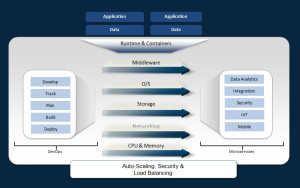In my previous post, “PaaS Scenario: PaaS, Path to the Future – Part I“, I introduced an example on how entrepreneurs and Startups can benefit from adopting a Platform as a Service (PaaS). PaaS offers them cost savings and similar access to computing power and capabilities as large enterprises. PaaS allow them to focus their energy on innovation and achieve their business goals.
In this post, PaaS High Level View, I will highlight its makeup.
PaaS High Level View: So what is a PaaS?
The massive paradigm shift in technology is equally impacting small, medium and large enterprises’ ability on staying ahead of the innovation cycle. Agility, flexibility and disruptive innovation are today’s name of the game. While enterprises have to focus on their core business, they are faced with the challenge in accelerating their growth and boosting their operational efficiency. They see PaaS as the path to get ahead of the game.
At its core, PaaS is a multi-layer environment. The first layer provides the computing power, networking and storage. This layer is referred to as an Infrastructure as a Service (IaaS).
The second layer is the middleware which includes databases, application servers and other supporting middleware capabilities.
The third layer consists of the additional services including auto-scaling, load balancing, failover, security, backup & restore, operability and monitoring.
The forth layer is the runtime environment. This layer supports a heterogeneous development environment offering a variety of choices from the popular Node.js to develop server-side JavaScript apps, PHP, Python, Ruby, Java, .Net, Node-Red and many others. Basically, developers can create their own customized platform by selecting the computing power, networking and storage. They can then specify the middleware components and the runtime environment. They can then bring their code to run it on that platform without worrying about maintaining the infrastructure or the middleware layer.
The Microservices layer is a capability offering layer. Microservices provide targeted capabilities such as time-series analysis, NoSQL databases with JSON document stores, data & business analytics, integration, queuing, data logging, application security & vulnerability, mobile, IoT, voice & text messaging (e.g. SMS), VOIP (e.g. Twilio) and more. Applications can be created, composed or extended using Microservices. Developers can consume the Microservices into their code to accelerate the development and build differentiation into their applications.
In my view, the Microservices layer plays a critical role in differentiating PaaS vendors from each other. For example, IBM added more than 16 of their Watson services to their IBM® Bluemix™ PaaS platform, everything from language identification, to machine language translation. They also included the classic Q&A service that you saw first when Watson beat the Jeopardy champions a few years ago. Developers can now add cognitive analysis capability to their software by simply consuming the power of Watson Cognitive computing Microservice into their applications.
PaaS leveled the playing field allowing individual developers, Startups and large enterprises alike to have equal access to all these Microservices.
The DevOps layer in the figure above is a Software as a Service (SaaS) that augments the capabilities of the PaaS. Along with the PaaS heterogeneous runtime environment, this layer brings together the planning, tracking, source control management, building (compiling) and deploying capabilities to the Cloud. It aligns PaaS with DevOps to achieve a software delivery pipeline with better collaboration and lifecycle traceability resulting in a significant productivity gain and fact-based decision making.
[AdSense-C]
In my next post I will describe some possible PaaS usage scenarios.
About the Author
 Sami Joueidi holds a Masters degree in Electrical Engineering and an Enterprise Architecture certification from Carnegie Mellon. He has over 20 years of experience as a technical leader of complex IT projects for Fortune 500 firms, in diverse roles such as Systems Integrator, DevOps, Cloud Architecture, Enterprise Architecture and Software Development & Release Management. He guides customers on how to leverage the latest technology trends to their advantage and helps them with their Cloud adoption strategies.
Sami Joueidi holds a Masters degree in Electrical Engineering and an Enterprise Architecture certification from Carnegie Mellon. He has over 20 years of experience as a technical leader of complex IT projects for Fortune 500 firms, in diverse roles such as Systems Integrator, DevOps, Cloud Architecture, Enterprise Architecture and Software Development & Release Management. He guides customers on how to leverage the latest technology trends to their advantage and helps them with their Cloud adoption strategies.
© Sami Joueidi and www.cafesami.com, 2015. Excerpts and links may be used, provided that full and clear credit is given to Sami Joueidi and www.cafesami.com with appropriate and specific direction to the original content.


Do you like to comment?